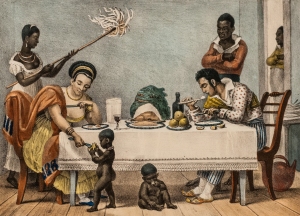Feijoada is more than Brazil’s best-known dish—it’s a culinary reflection of the country’s layered social history. Made from black beans, assorted meats, and typically served with rice, collard greens, orange slices, and manioc flour (farofa), feijoada traces its roots through centuries of migration, labor, and adaptation. It is a dish of shared labor and shared tables, still prepared ritually in homes and botecos across the country every Saturday.
Origins in Contested Histories

Popular lore connects feijoada to enslaved Africans on colonial plantations who cooked discarded cuts—ears, feet, tails—with black beans. But this origin story is increasingly questioned by historians. Similar stews existed in medieval Portugal, such as the cozido, combining legumes and salted meats.
Rather than a single point of invention, feijoada likely evolved from a convergence of European techniques, African ingenuity, and Indigenous ingredients—a result of forced coexistence under colonization.
Resistance in a Stew
Feijoada is a dish of endurance. In quilombos—settlements formed by escaped enslaved people—feijoada became a communal meal. It was cooked and eaten together, reinforcing identity and solidarity.
Over time, the recipe expanded. Bay leaves, collard greens, orange slices, and farofa were added—each with a functional role in digestion or energy balance. By the 19th century, feijoada had moved from the margins to urban centers. In Rio de Janeiro, it was adopted by working-class eateries and became a Saturday staple. When Café Lamas listed it on its menu in 1833, the dish crossed a symbolic threshold: from marginal to mainstream.
This shift did not erase inequalities, but it marked feijoada’s transition into a symbol of national cuisine.

Food and Community
In the 1920s and 1930s, feijoada found new life alongside samba. In spontaneous rodas—music and dance circles—it became both sustenance and social glue. Samba schools began hosting feijoadas comunitárias, not just for fundraising but as platforms for community building and political discussion. These gatherings still happen today in neighborhoods like Mangueira, Portela, and Salgueiro, and in cities beyond Rio, including Salvador and Belo Horizonte.
A National Dish with Regional Dialects
There is no single feijoada. Every region interprets it differently:
- Bahia: Hotter and spiced with chili, dendê oil, and cilantro.
- Rio de Janeiro: Elaborate and festive, served with flair.
- São Paulo: Subtler, often paired with caipirinhas.
- Minas Gerais: Earthy and slow-cooked, sometimes in wood-fired ovens.
In all its forms, feijoada is not cooked for one—it’s made to be shared. The process is long and deliberate: soaking beans, desalting meats, preparing aromatics, simmering slowly for hours. The dish defies fast consumption. Its preparation is an act of cultural continuity.
Migration and Reinvention
As Brazilians have migrated, feijoada has traveled with them. In Tokyo, it’s lighter. In Lisbon, it bridges old and new Lusophone cultures. In London and the U.S., it adapts to local ingredients—sometimes too much, losing part of its identity.
Still, wherever it goes, feijoada carries symbolic weight. For many in the diaspora, tasting it is a return—an edible link to home.
Contemporary Variants
In recent years, a vegetarian version has gained popularity in urban restaurants and festivals. Made with mushrooms, tofu, and squash—while keeping the black beans and farofa—it reflects ongoing adaptation. Some purists criticize it, but feijoada has never been static. Improvisation is part of its legacy.
Cultural Activism Through Cuisine
Today, feijoada features in grassroots activism. Feminist groups, Indigenous communities, and Afro-Brazilian movements cook and serve it as part of food education, hunger relief, and solidarity economy projects. It is sometimes called gastronomia decolonial—a way to reclaim heritage and affirm presence.
Feijoada, then, is not simply a dish. It’s a medium of resistance, memory, and belonging.
Traditional Feijoada (Serves 8)
Ingredients:
1 kg dried black beans300 g dried beef or smoked brisket
500 g smoked sausage
300 g pork ribs or belly
2 pig’s ears or feet (optional)
1 large onion
3 garlic cloves
2 bay leaves
Oil, salt, and black pepper
Collard greens (sautéed)
Orange slices
Manioc flour (farofa)
White rice
Instructions:
Soak beans overnight.Desalt meats in cold water, changing water several times.
Blanch salted meats to reduce fat.
In a large pot, sauté garlic and onion. Add beans, meat, bay leaves.
Cover with water and simmer for at least 3 hours.
Season with salt at the end. Serve with rice, farofa, orange, and greens.





